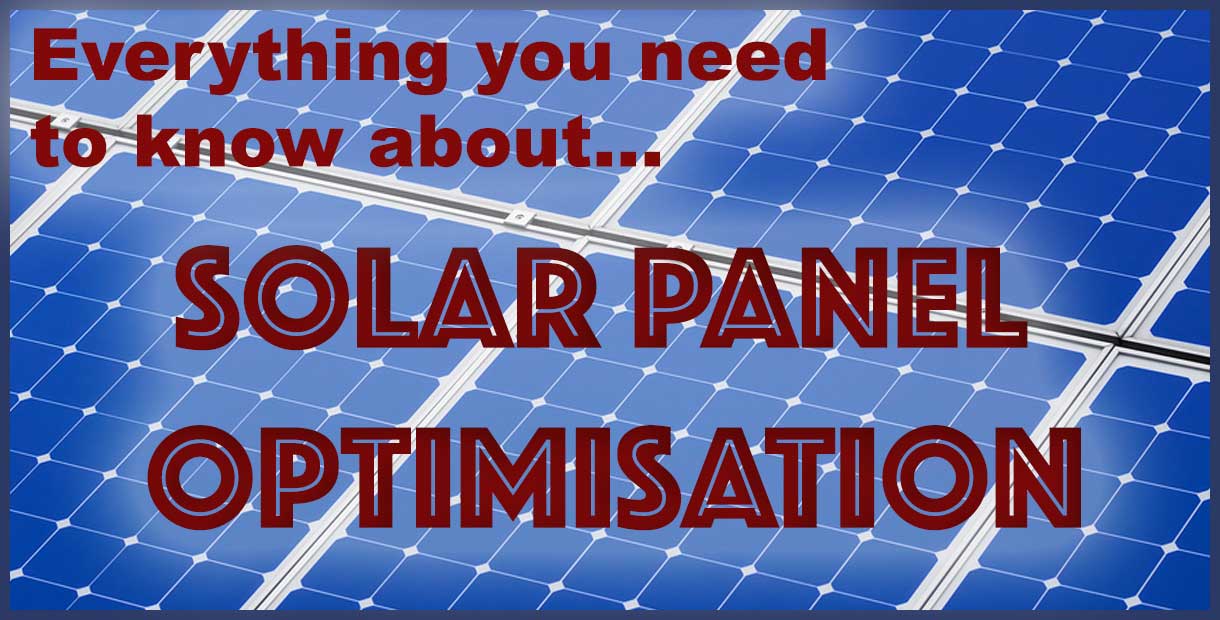
Solar Panel Optimisation is an extra feature you can pay for when buying solar that optimises the power output from each panel independently.
This feature can also be called:
- Panel Level Optimisaton (PLO) and
- Module Level Power Electronics (MLPE)
For the rest of this post, I’ll simply call it PLO.
Most people don’t realise that in a conventional solar power system if one panel is performing poorly, all the other modules it shares a ‘string’ with will be dragged down too.
What is a string?
In a conventional system, solar panels are connected together in ‘strings’. Each string is a number of solar panels wired in series like this:
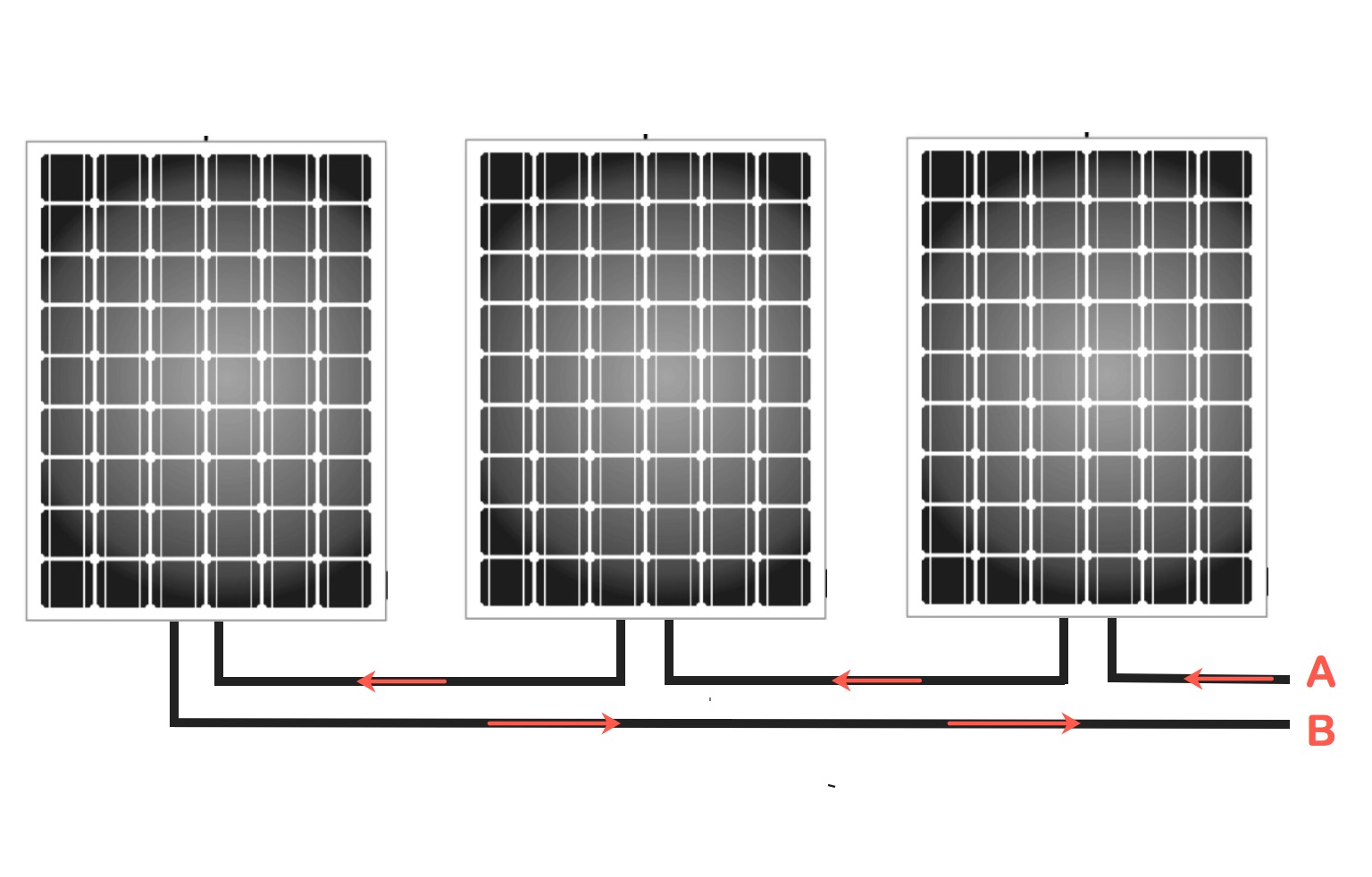
If that does not make intuitive sense to you, think of the current in the wire as water in a hose. A shaded panel will ‘pinch the hose’. That means all the panels have less current through them.
The practical result of this is that if one is shaded, only operating at 50%, all the panels it its string will now operate at 50% too.
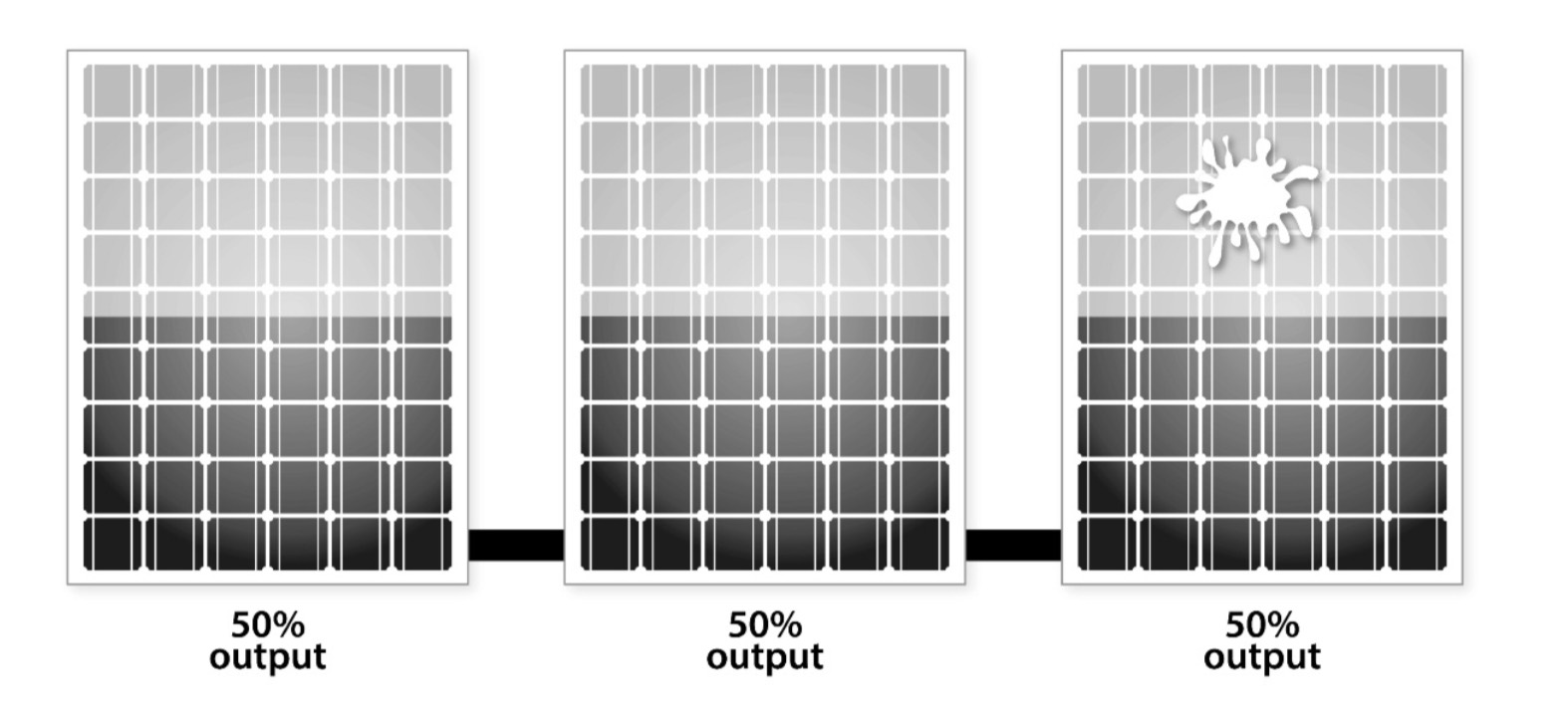
Three solar panels connected together; if one loses output, they all lose output.
Bypass diodes?
“Ah, but Finn”, the more knowledgeable reader says about now, “it’s not that bad. That’s why we have bypass diodes!”
Some people have suggested to me that bypass diodes solve the problem of one solar panel affecting all the others in the string. Some solar sales people wax lyrical about bypass diodes, especially if they are selling a conventional system and the competition is selling an optimised system.
Here’s what you need to know about bypass diodes: they do not optimise the panels individually, the only make the situation a little less bad.
What is a bypass diode?
If we zoom into a solar panel, you can see that a typical panel has 60 solar cells. All the solar cells are wired in series. The current flows as per the red line:
Current entering the solar panel has to go through every single cell before it gets out of the module. So if only one of the sixty cells is shaded, the current is restricted through all the cells in the panel. Bummer.
To reduce the effect of shaded cells, most panels have 3 bypass diodes that connect across the cells like this:
These diodes (drawn in green) are like little electronic pressure relief valves. If a cell is blocked, the current will instead move through the closest diode, bypassing a third of the cells.
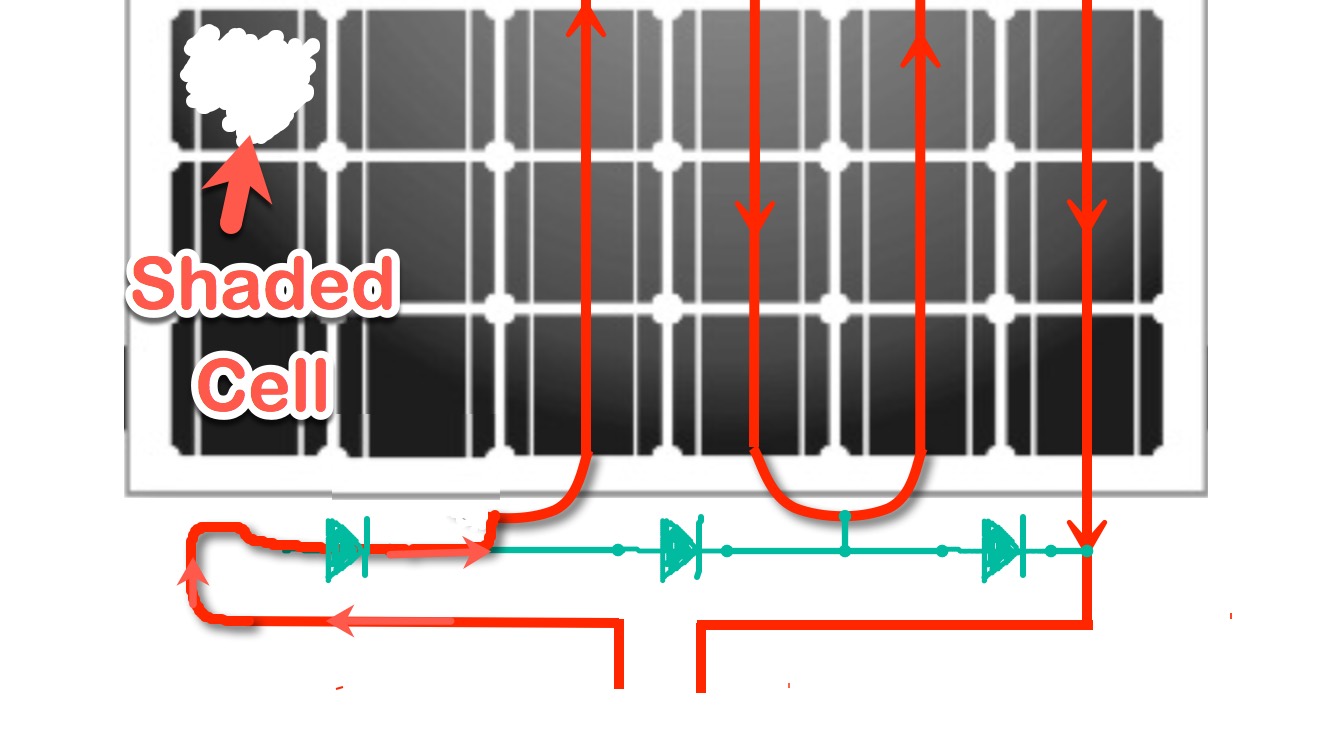
The 3rd cell is shaded, so the current goes through the first bypass diode, bypassing one-third of the panel.
Without the bypass diode, the current would stop at the shaded cell and the panel would produce nothing.
With 3 bypass diodes, one fully shaded cell will not stop the entire panel passing current. The current will be diverted through the local diode and the solar panel’s voltage and power output will reduce by one third. The panel’s current will stay the same though (P=VI) so it won’t adversely affect the other panels.
The problem comes when there is not enough shade to activate the bypass diode. Then power drops and the current through the panel drops with it. This drop in current affects the current in every other panel in the series string.
So although bypass diodes help – they only help when you have the ‘right amount’ of shade in the right place.
The solution is ‘Panel Level Optimisation’
With PLO, a device is placed on each panel that ensures they can pass the maximum current no matter how badly it is shaded. So a solar panel that is shaded by 50% does not affect others in the string:
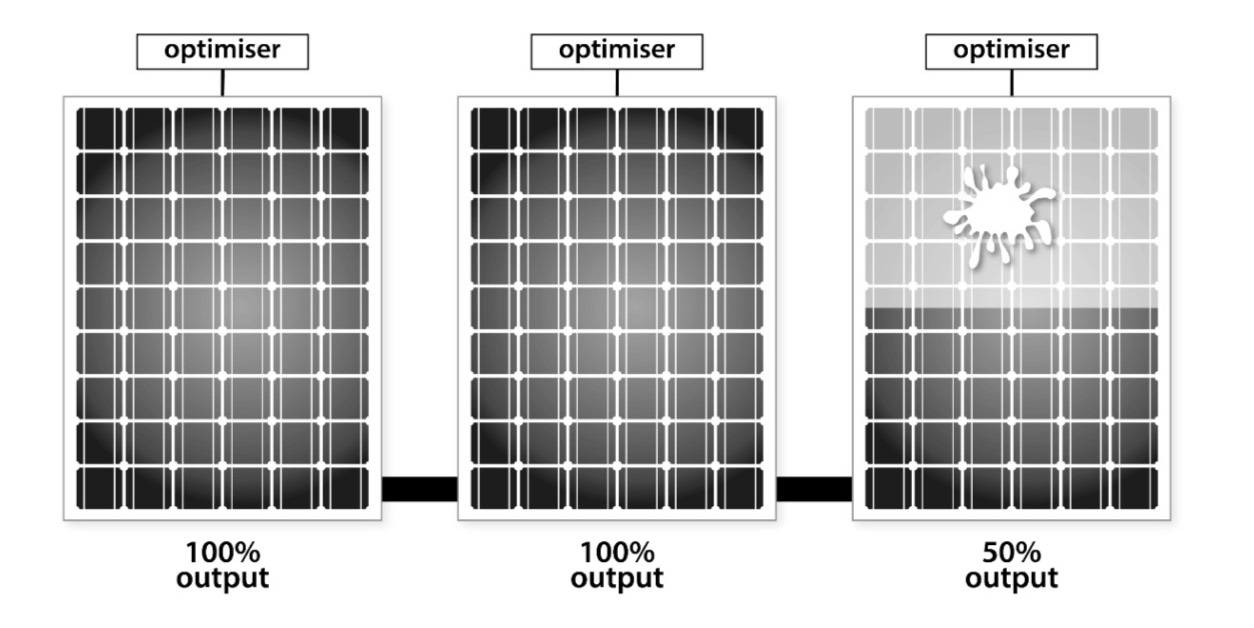
An optimised solar panel system confines the reduced output to just one panel.
There are four ways to achieve PLO:
- Discrete DC Optimisers
- Smart Panels (Integrated DC Optimisers)
- Maxim Panels
- Microinverters
Each one adds to the cost of your installation:
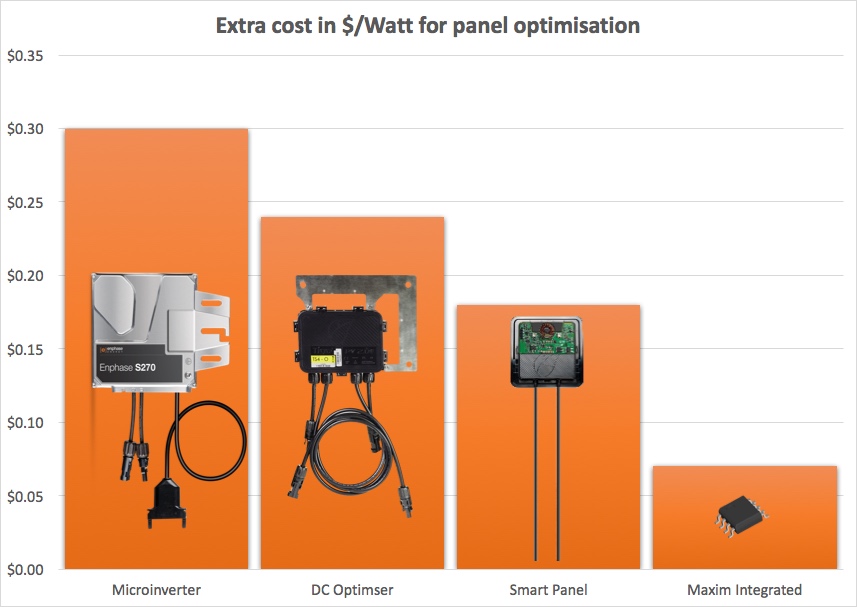
If you add panel level optimisation, your solar power system will cost more.
For a $6,500 6.6kW solar system, typical additional cost for PLO would be:
- Microinverters $2000
- DC Optimisers $1600
- Smart Panels $1200
- Maxim Panels $500
Now let me explain what each option actually is.
Optimisation Solution #1: A ‘DC optimiser’ box on each solar panel
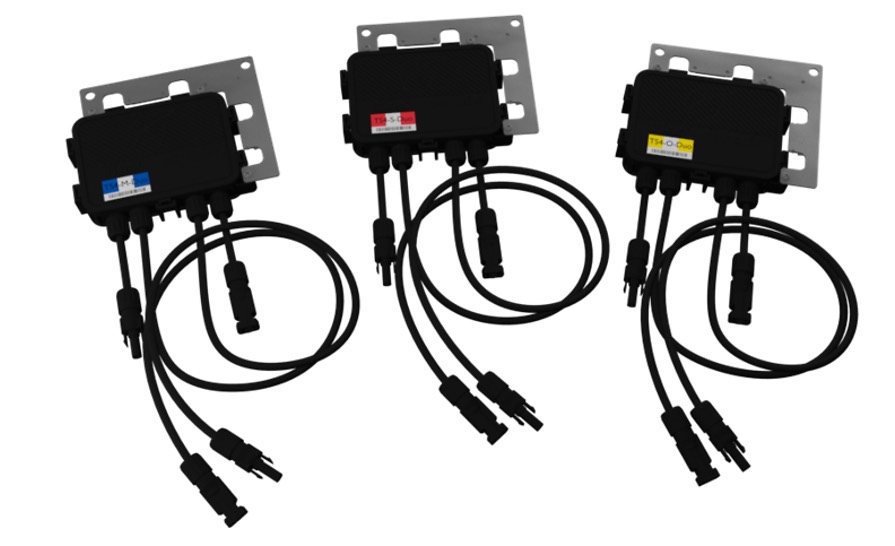
Tigo DC optimisers that bolt onto the back of solar panels.
If you choose this option, your installer will attach one DC optimiser to each solar panel, optimising each module’s power output under a wide variety of conditions.
The power generated by all the panels is transmitted at high voltage DC (typically 200-600VDC) and a single, string inverter, typically wall-mounted, does the DC to AC conversion.
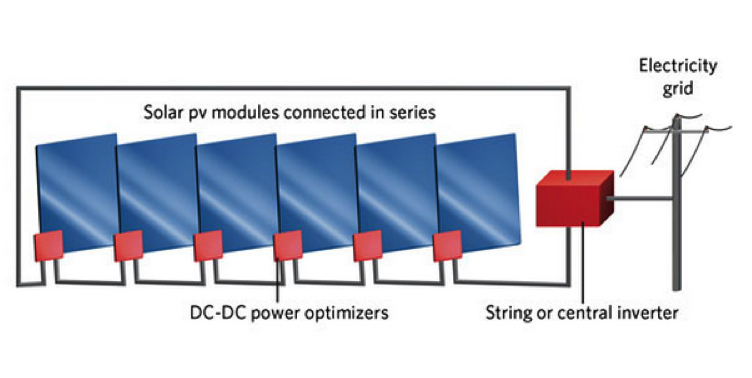
A solar system with DC optimisers. It still needs a string inverter too.
If you want to buy your string inverter and DC optimisers together as one package, then the only game in town is either SolarEdge or the (very new) Huawei. These guys will sell you the inverter and optimisers together, which has the advantage of really schmick software that monitors and controls the whole system. SolarEdge also offer one of the best inverter warranties in Australia at twelve years.
If you don’t want to be constrained to using a SolarEdge or Huawei inverter then a company called Tigo makes individual DC optimisers that work with almost any string inverter. They cost about $100 each, and if you want to monitor the optimisers, you’ll also have to shell out about $600 for a central communication unit. Of course, you’ll still have to buy a string inverter too.
The biggest advantage of a DC optimiser that is independent of the string inverter – like Tigo – is you don’t have to put them on every solar panel. If you have an installation in which only a few panels will get shade, then you can only add optimisers to those – saving lots of money compared to putting them on every module. Savvy solar installers often do this to reduce the effect of stink pipes, TV aerials and chimneys on the system output.
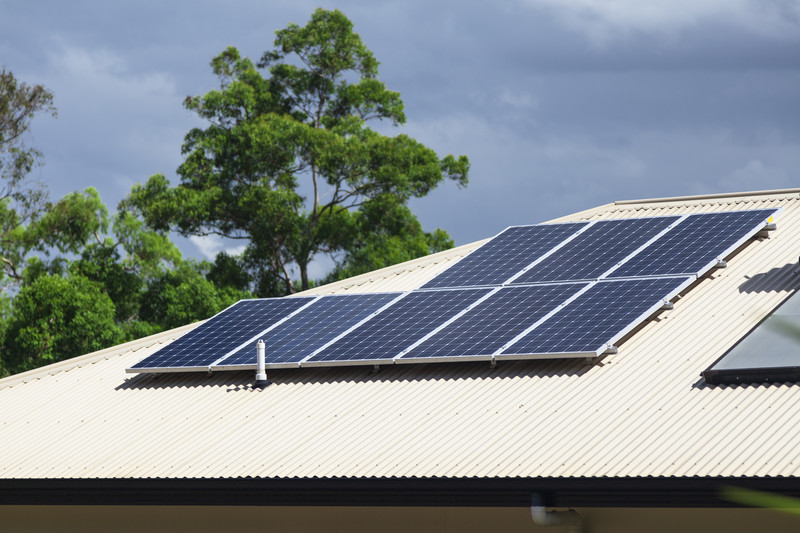
To minimise the effect of the stink-pipe you only need to add DC optimisers to the panels that it casts shade on to.
Optimisation Solution #2: Smart panels
A ‘smart panel’ is a simply a regular solar panel with a DC optimiser (probably made by Tigo) pre-installed at the factory. They can be used with a string inverter of your choice and are usually cheaper than buying the optimiser and module separately.
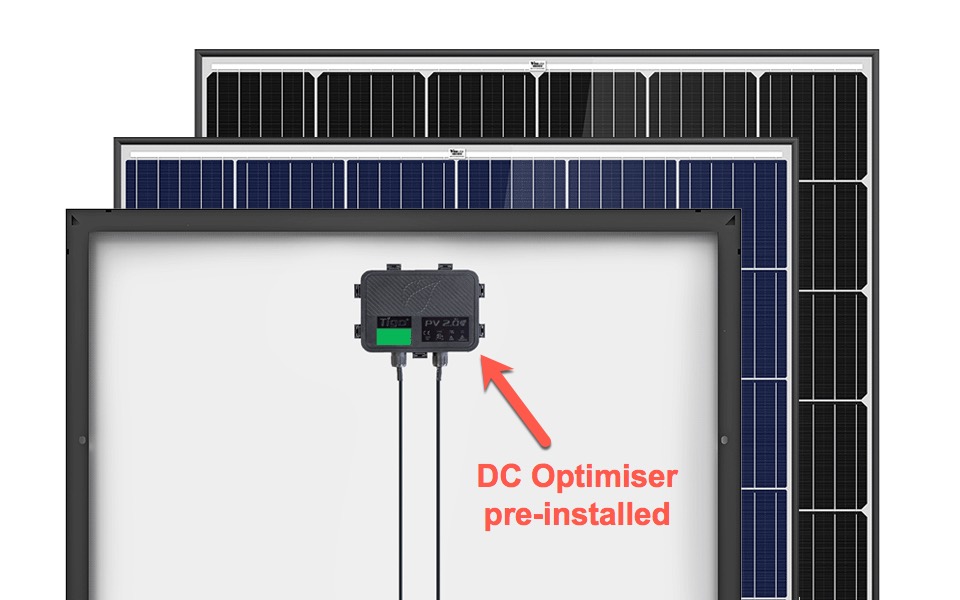
A smart panel with DC optimiser pre-installed at the factory.
Solution #3: Maxim smart panels
Maxim is a microchip company that in 2016 invented a little chip that can optimise the power in an individual solar panel. In fact, they claim that replacing the three bypass diodes in a typical module with three of their chips will optimise the power at the solar-cell-string level.
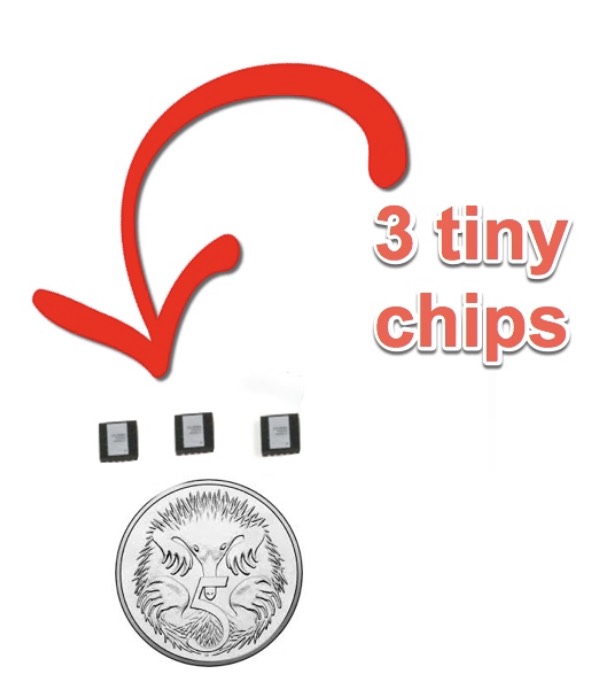
In a Maxim panel these 3 microchips replace the bypass diodes.
As you’ve already seen, a cell-string is typically a third of the solar panel. If the current is reduced though a cell due to shading, a Maxim panel will get as much power as it can from the shaded cell-string while still allowing the other two cell-strings to perform at full power.
So a Maxim smart panel, as well as ensuring that one shaded panel will not bring down the others in a string, will under many circumstances get more power from the partially shaded module too because it won’t simply bypass a third of it, but get as much power as it can from the shaded cell-string.
The extra cost for Maxim smart panel optimisation is about $70 per kW. Maxim don’t manufacture the panels; they sell their chips to module manufacturers – at the time of writing, Jinko Solar, Trina Solar, Suntech and ET Solar. This is the cheapest way to get panel level optimisation. The downside is that we are seeing major TV reception issues with Maxim solar panels, to the extent that Jinko have decided not to sell them in Australia anymore and Trina, Suntech and ET have gone very quiet on their Maxim panels in Australia.
So if you really want Maxim modules, you will struggle to find any in Australia at time of writing. Which is a shame because they are a great value and effective solar panel optimisation solution (for people who don’t watch broadcast TV!).
Solution #4: Micro-inverters
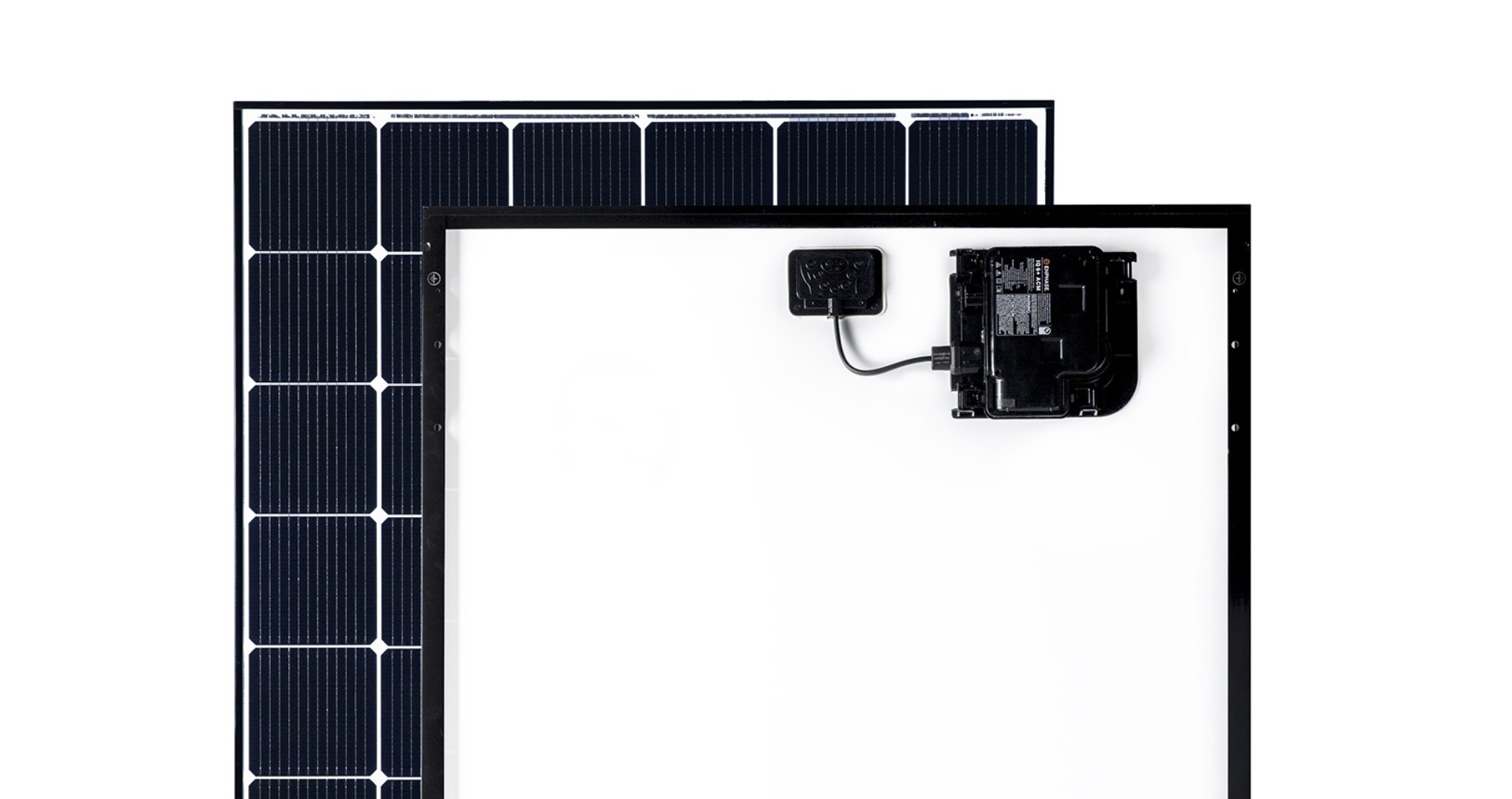
A microinverter on the back of a solar panel.
Micro-inverters are a totally different approach to PLO. They take all the functions of a string inverter and miniaturise it to the solar panel level. Consequently, each solar panel has its own integrated optimiser and inverter attached either on or under each individual module on the roof:
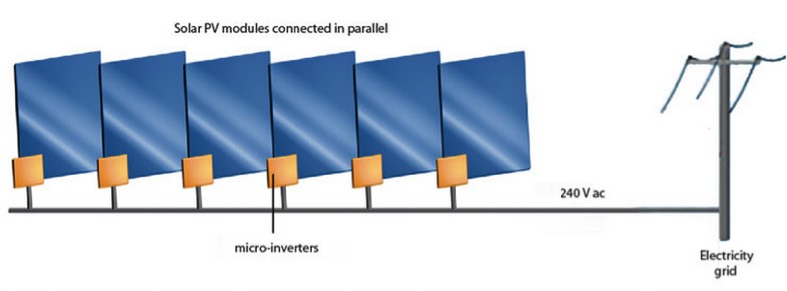
Microinverters keep everything at 230V AC. No string inverter required.
The power generated is transmitted at 230V AC (not 200-600V DC) from each micro-inverter and connected in parallel, then connected directly to your switchboard.
They are the most expensive way to get PLO but they do have these features that the other 3 options don’t:
- No high voltage DC on your roof. The whole system is 230V AC
- No central point of failure. If one micro fails you only lose that solar panel. If a string inverter fails you lose the whole system.
Which PLO should you choose?
Maxim panels are out of the contest, because you just can’t seem to get them in Australia. So that leaves DC optimisers (integrated or discrete) vs. microinverters.
Back in 2015 I put together this infographic to help you decide (and this blog post too). If you need help deciding on a PLO solution they are a great resource.
Do you need Panel Level Optimisation At All?
- If you have a simple roof facing 1 or 2 (or possibly 3) directions with no shade, then there is no pressing need to spend more on PLO.
- If you have a simple roof with no shade, and want to squeeze 8-12% more energy from your solar panels, then PLO can do that by simply optimising everything better (by better coping with panel manufacturing mismatch, cloud cover, dirt etc.).
- If you have a complicated roof, with lots of roof faces and/or lots of shade objects (flues, aerials, ventilation etc.) then PLO is a good idea.
- If you only have one or two small shading objects that will only shade a handful of panels, then retrofitting Tigo DC optimisers to the affected solar panels is the most cost effective solution.
- Microinverters and DC optimisers offer panel level monitoring, so you can see the power of each module on your monitoring. If that is important to you, then get it. But in my experience it soon gets boring!
- All well-installed solar systems are relatively safe. But microniverter systems are even safer by design (no high DC voltage), and DC optimisers and microinverters both shut down the solar panels fully in fault conditions – increasing their safety. So if that is important to you, consider PLO.
What have I got? On the house I live in I chose to install microinverters. The main reason being that the house is made of straw, and I didn’t like the thought of 600V DC going through the bales. But normal people without weird homes shouldn’t be too concerned – as already mentioned, a well installed DC system is perfectly safe.
So now you know everything you need to know about solar panel optimisation, or PLO, you can decide for yourself if you need or want it and if so which flavour to get. What have you chosen and why? Let rip in the comments.

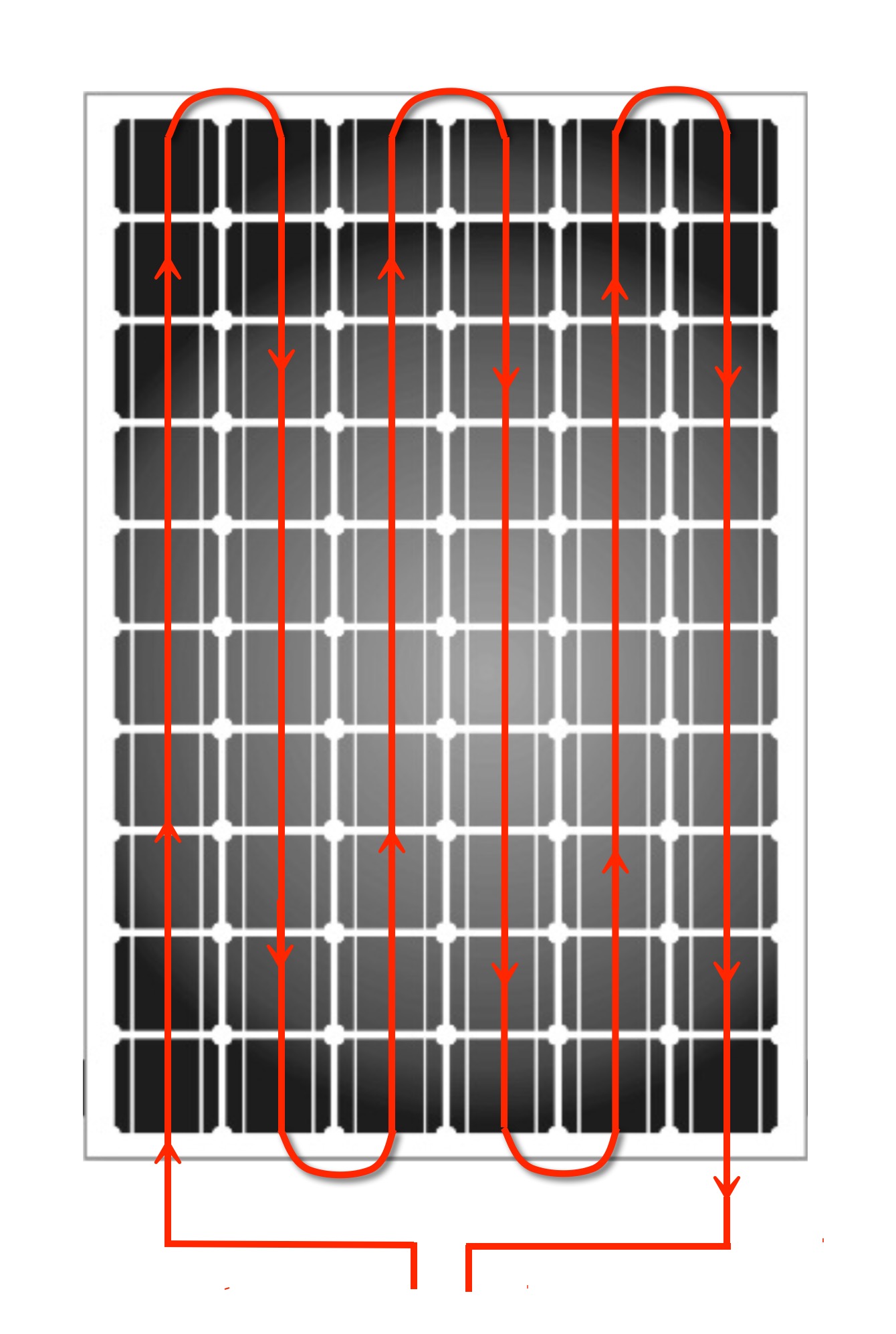
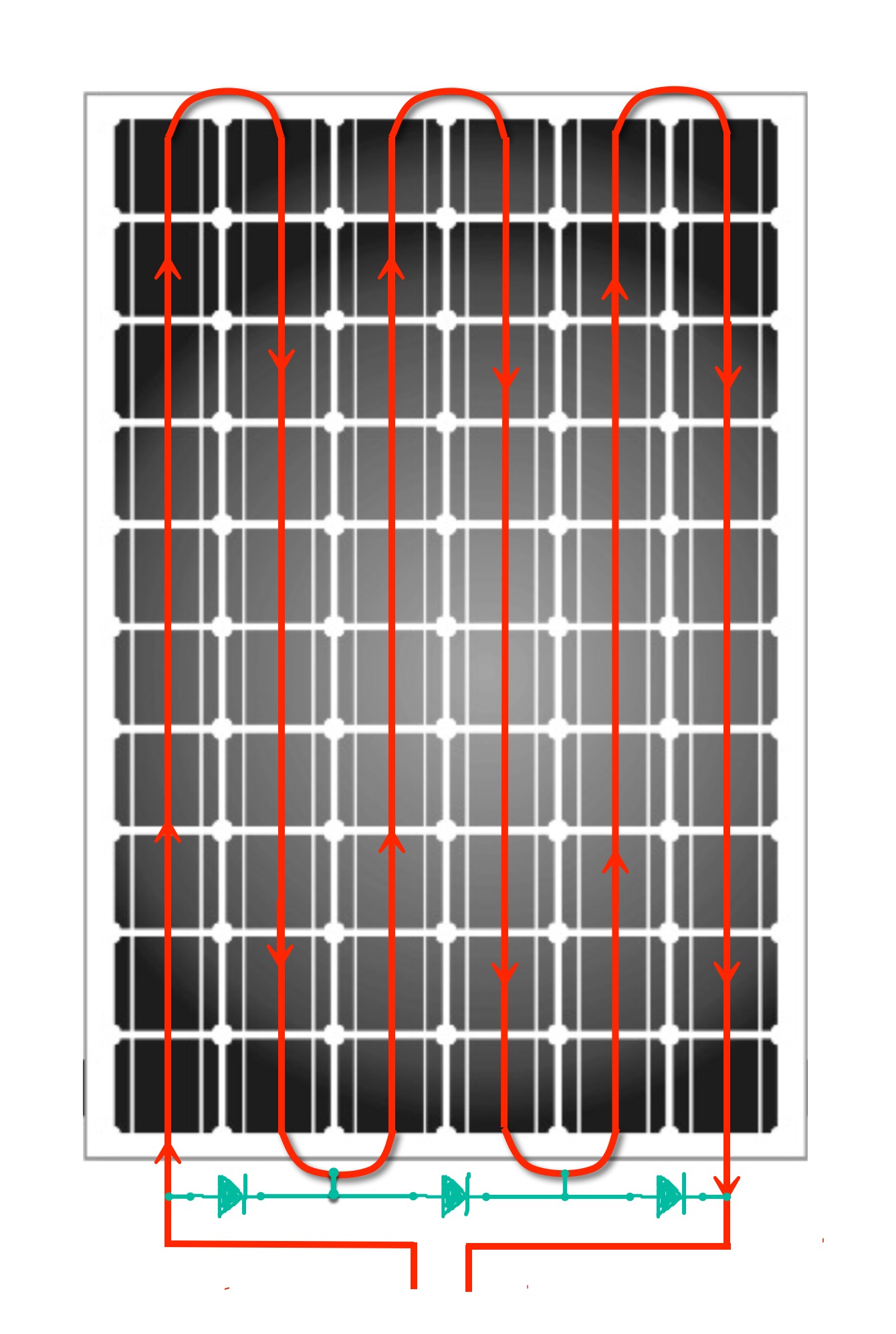
 RSS - Posts
RSS - Posts



[What have I got? On the house I live in I chose to install microinverters. The main reason being that the house is made of straw, and I didn’t like the thought of 600V DC going through the bales.] Yep, and since 2013, I have a microinverter-based system, too. The system has never been down 100%. Plus, I built it in subsets, and now am happy with 6 strings, 20,000-Watts of AC power. In 2019, I plan on retrofitting my system to give me a 10kW microgrid, that is, when the utility grid goes down, my solar will continue to operate — powerful. From recent blurbs at the Enphase shareholder meeting, it looks like all you will need is a single IQ8 battery or IQ8 microinverter plus the addition of an IQ Envoy, and it will be able to put all of the microinverters into the microgrid. I am hopeful. I always look at microinverters 100% decentralized power topology as a Cadillac solution, plus all the devices in my home were AC, so it made sense to have AC coming off of the roof. DC arc faults are real safety hazards, and, of course, a newly installed solar PV system is perfect and powerful, but put 10 years on it in Florida tropics, and the idea of a DC arc fault is very real. AC is the way to go. Great article Finn from the Land Down Under! Cheers from the States!
The Tigo product works well, but the company is let down by an awefull warranty claim process. The amount of ‘testing’ a installer needs to do (uncompensated) to prove a fault makes it a product that is essentially a liability to an installer who offers an extended workmanship warranty. It is a shame as the product is good and the software consumer friendly.
I think Tigo is the best company I have ever dealt with in my 40 years of contracting. If there is a problem they can log onto system, troubleshoot and
see if they need to do something with the software or if there is a bad optimizer.
I have never had the level of support I get with them with any company selling anything. I can’t say enough good things about them.
I have a solaredge system with DC optimisers and very happy with it.
One thing that seems to occur and is rarely mentioned is the effect of the house next door, shading solar panels.
Logic would suggest that solar panels should be fitted high up on the roof, but all installations seem to place them at the bottom of the roof, ie close to the storm water guttering. Why is this? In my case i get shading from the roofline of the home next door in the afternoon. (I have 5 panels on west roof and 7 on the Nth in a 4kW system)
Any solar installer worth their salt should take shading into account when siting panels. So it sounds like your installer got a little salt they weren’t entitled to if they had the option of placing the panels higher. That said, all else equal, it is best to avoid placing panels close to the roof crest as wind loading can be high there. This is especially important in cyclone areas.
Most if not all solar installs i see around here do the same thing. Panels low on the roof line. We are not in a high wind area either.
If it’s a tile roof they probably wanted to steer clear of the ridge capping. You pretty much have to fix your first rail at the bottom of your third tile down if you want to avoid disturbing an old/crumbling ridge line. Customers rarely consider blokes traversing their double storey roof carrying panels, yet they will 100% notice water dripping down a light fitting on a rainy day. I’d say this is likely reasoning for a lower install scenario as most guys would prefer to panel with tiles under their feet as opposed to the single tile above a gutter line.
hi
I have a solar edge system but the led screen on the inverter. Is saying there are three pins failing which I believe are the optimisers on individual panels .one had not been working for a while but was still producing sufficient kw now two more have failed and it is producing next to nothing , should this happen
Regards Christopher ……uk
I get awesome efficency from my Enphase Micro system even on the crappy winter day it will register a resonable amount of Solar, looking forward to seeing how the new I.Q range Enphase Micros go ! for me the nephase may be a bit more to spend but the simplicity of the application is a winner!
I have a enphase 5.5kw system it works awesome I had one panel go faulty after 3 years and you could see the problem, as that panel had a different color on the enphase app. This panel was replaced and system is working well. We get a lot of shade from the forest close by in winter as the sun drops behind the trees so it was a no brainer to get an Enphase.
Great article, thanks Ronald.
Just a couple of points to add. One advantage of micro inverters that you didn’t mention is that you can add more panels to your system very easily without having to upgrade your inverter.
And an advantage of any type of PLO (I was told this by a Tigo rep so I’ll be interested in your opinion) is that, as the panels degrade over time, they tend to degrade at different rates which leads to ‘voltage mismatches’ between the panels. Apparently this is bad but PLO is good because it fixes it.
Also you dismissed panel-level monitoring as something that only geeks and nerds like you an me would be interested in but I think everyone would want to know if one of their panels was underperforming and with PLO it’s easy to find out which one is causing the problem.
One question, with the Maxim chips, do you get the same sort of panel-level monitoring and fault detection as with optimisers or micro’s?
Cheer, Andy
Unfortunately there’s no panel level monitoring or fault detection with Maxim panel string optimization. It’s a trade off for lower cost.
Sorry, I didn’t mean to limit you to only one cheer. Have as many as like…
Cheers, Andy
Actually I don’t deserve any cheers as it was Finn who wrote the article.
Does anyone actually have the Huawei product? We’ve been waiting for years…
One Stop Solar Warehouse has the Huawei optimizers on their site and others may as well.
I have TrinaPeak panels (Maxium optimised). I don’t have TV interference issues people are talking about with either an attenna facing Dandenong or Melbourne (Bourke St) with 2 sets of frequencies.
Maybe people’s mileage varies or maybe the implementation on the panel is the issue.
Hopefully Trina has the interference problem sorted. But generally it was only people with weak TV reception who had problems so your signal may be strong enough to avoid problems. Hard to say.
Hi Finn. Love you work. have been reading your blog for years and would have to say I have agreed with everything you have said up until today.
“But in a conventional system that still makes every other panel in the string reduce by a third too.”
I would have thought that if I had a good MPPT and the inverter let the voltage go down by the amount of shaded Cells the rest of the panels would still supply full current thought the bypass diode and not reduce their output.
Maybe I’m wrong and MTTP aren’t that smart and just look near Voc. Think I will have to run some experiments to see if you have indead sold out to the optimizer crowd.
A 3 Kw system plus microinverters were installed in 2013 here – we needed microinverters (this was unfortunately pre DC optimisers) due to two large trees on another property providing random shading at no extra cost (to them).
Initially the new system would only monitor the panels on the north or east, never both.
Then the daytime TV reception was so poor that the installer spent an entire day footling around until (between us) we worked out the interference was on the same plane as the microinverters.
Then we removed the original TV antennas and installed another much taller post to get “out of inverter range”. Pity I hadn’t also checked the radio reception – it was still lousy.
I had a fair amount of mu metal (good RF shielding) so I shielded the microinverters to fix the radio reception. Result – good radio, no panels could be monitored. Why the manufacturers can’t use a basic cat5 network cable instead of wireless for monitoring is unfathomable to me.
So I thought I would change over to optimisers and allow for future expansion – mainly for battery backup and charging an electric vehicle. So our “beloved” power company refused to allow me to install a 3 phase 27.6Kw Solaredge inverter (needed for both EV and some high amperage 3 phase gear here) because the DC voltage is more than their recommended maximum “on the roof”. The inverter has TUV approval, however the regulator in the West is above such trivia. This is despite the fact that I can legally install 15Kw of panels as we have a 3 phase wiring system. Finally late last year they approved the Solaredge after 30 months of pressure from me (and undoubtedly quite a few others).
Currently I am building a 2 storey “mini dwelling” out the back and the whole thing will never see the grid… and all the heavy duty gear will be run off that instead of the original house. Much more of this snafu and the original house will also go off grid (complete with a second DC optimiser setup – temperature strips on the microinverters exceeded 100 Celsius in summer in 2015 – and all the years since have been hotter. I reckon I have been luchy to only blow 2 of the 6 microinverters so far. Unsuitable technology for summer in the West in my view.
Between the smart meter fiasco (we get a measly 7cents feed in tariff and get slugged 29 cents for imported power) and all the hassles above, the electricity regulators in the West have clearly demonstrated an utter failure to support new technology or their customers needs.
So here I am counting the days… one brick at a time.
The second half of : >> With 3 bypass diodes, one fully shaded cell will not stop the entire panel passing current, instead its output will reduce by one third.
But in a conventional system that still makes every other panel in the string reduce by a third too.<<
has lost me. As a string of panels is a string of three times as many 1/3 panels in series, a good bypass diode avoids any current restriction, with the only consequence of a dead 1/3 panel being reduction of the string voltage by 1/3 of a panel plus 1v diode drop. (OK, the diode would drop around 0.6 to 0.7v at low current, but at full string current you'll see around a volt.) That voltage reduction is 1/3 less power for one panel, 1/6 less power for two panels, and 1/30 less power for ten panels in the string.
If two strings were parallelled on one inverter string input, then the MPPT would have to tune to the lower voltage to pull _any_ current from the weak string, reducing the power drawn from the stronger string by 1/n also. So, yes, I can see that the whole array on that inverter string input is affected, but the impact will only be 1/n, where n = series_panels * 3, if solar glare isn't distorting my view of this effect.
Original article: “Without the bypass diode, the current would stop at the shaded cell and the panel would produce nothing.
With 3 bypass diodes, one fully shaded cell will not stop the entire panel passing current, instead its output will reduce by one third.
But in a conventional system that still makes every other panel in the string reduce by a third too.”
The 3rd paragraph is incorrect.1 fully-shaded cell/section reduces the value of that 1 bypassed section alone i.e. about 10V in the string voltage-under-load for a 60-cell panel with 3 BDs. The current flow is not affected, so the loss in power for *BOTH* the panel and the whole string will be 1/3rd of what that one panel would normally produce under this level of irradiation.The MPPT point will adjust and I believe the MPP V would then be 10V lower in this MPPT channel.
Of course, the more DB sections that are being bypassed, the more 1/3rd panel V and 1/3rd-panel P contributions to the string’s total V & total P that are being lost. Eventually, the string V will drop below the range that MPPT operates within, causing even more P loss. And, finally, the string V will fall below the min. inverter operating V.
Then you have the situation where the shading in a section is insufficient to operate that section’s BD. This will drag the I (current) down. Due to the series connection of all the cells in the panel AND in the string too, (unless operating parallel strings in a MPPT channel), the whole string’s I will be dragged down. THIS IS MORE SERIOUS AS THE I REDUCTION IS PROPORTIONAL TO THE SHADED AREA OF EVEN JUST ONE CELL IN AN UN-BYPASSED SECTION. (See https://www.pveducation.org/pvcdrom/7-modules-and-arrays/shading)
With complex shading, say from leaves and branches, you get the situation, where string power loss is occurring due both to I (un-bypassed sections) & V (bypassed sections) loss. In the Whirlpool Forums post below I showed the actual change in V, I & P change when early-morning shading in my PV array changed a string from I & V reduction to just V reduction:
https://forums.whirlpool.net.au/forum-replies.cfm?t=2725934#r15
Hi Finn,
I’ve recently taken up your offer of 3 quotes, for a new build on a block where a neighbour’s large (“significant”) gum tree is likely to provide morning shading.
1) What tools are readily available to me to assess potential shading?
One of your recommended suppliers has suggested his recommended way of dealing with the expected shading is to use Suntech Maxim-optimised panels (STP270-20/Wfw-MX)
2) Have you come across these particular panels? I couldn’t see a review for the specific model – but maybe I was having a man’s look….
I asked about microinverters and he was strongly anti – said he had installed a large base of them and was rueing that, due to the long tail on service obligations:
3) Are microinverters significantly more prone to failure than monolithic string inverters, or is it likely to be a combination of more articles to fail and more inconvenient to replace, that weigh against them from a reliability perspective?
I asked about Maxim’s issues with RFI and his take was that these Suntech panels used “second generation Maxim chipsets” and weren’t an issue, with an installed base from late last year onwards (Nov?). Just wondering:
4) “second generation Maxim chipset” – is much known about this?
5) apart from the chips, which one expects would be rated to industrial temps, what sorts of passives are likely to be in the panel-mount electronics – eg hopefully no electrolytic caps…
So many questions… hoping you can spare some time to comment
Cheers
Hello John, Ronald here.
The good news is, because it is winter, the shading from the tree won’t be much worse than it is now so you can get a good idea of its worst extent (assuming the tree isn’t going to grow much more). If you are in Queensland you can require neighbors trim or remove trees shading your property.
A Suneye can be used to measure the effects of shade:
https://www.solarquotes.com.au/blog/how-to-be-sure-that-shading-wont-kill-your-solar-power-systems-output/
Hopefully your installer has already used this or a similar tool. If not we may still have one we can lend.
Some microinverters haven’t performed well but generally I would say they are now reliable. I’d suggest making sure they come with a 10 year warranty though. You are right that having multiple inverters increases the chance of one failing, but the others will keep on functioning.
Maxim optimized panels can give most of the benefits of microinverters at a lower cost. Most people did not have trouble with interference even with the first generation ones but I don’t know how well the second generation performs. If you get them and have problems please let me know.
Maxim panels apparently have just 3 little chips:
https://www.solarquotes.com.au/blog/maxim-just-killed-microinverter-dc-optimiser/
I spoke to a Maxim representative and he was quite confident they would last for the life of the panel.
Hi Finn, great article. I have recently had 6.6k system installed as great value in Victoria at the moment and needed to take the plunge. My house is due for an extension soon where the new roof will be optimised for solar. The system at present suffers extensive shading so I want to add panel optimisers. Sunboost supplied the system with seraphim 275w panels and a solis 5k inverter. My question is “ What are the options for me at this stage?” Regards E
Hi Edward, Ronald here.
I take it you want to put optimizers on your existing solar system? Tigo is the most commonly used optimizer with possibly Huawei coming in second. The bad news is it will be quite expensive to add them to an existing system. With 24 panels it will add up. Ideally optimizers might increase the output of your system by 25% but a result of half that is more likely.
Are you planning to add a second solar system on your roof extension? If so, you may be better off leaving your current system as it is and putting the money towards getting a larger second system. That could provide more additional solar energy per dollar spent than getting optimizers on your old system. (Even if you decide to put optimizers on the second system it will be cheaper than retrofitting them onto an existing system.)
If you are going to “upgrade” your existing system with optimizers, you may want to wait for IQ8 micros. Although it might be more expensive than just adding optimizers, you’ll get microgrid capability. You’ll need to add an Encharge Switch and an IQ Envoy, too. IQ8 will be the cure for “anti-islanding”!
Which products offer the best coastal warranties? I’m about to build a house along the coast but I’m unsure what the warranties are for solar panels and dc optimizer/enphase micro-inverters. My house will be about 400m away from the ocean. I want solar panels that are managed either by DC optimisers or enphase micro-inverters.
All the solar panels we recommend in our Solar 101 Guide should have no problem resisting corrosion 400m from the ocean:
https://www.solarquotes.com.au/solar101.html
If you want to be certain you can check with your installer or the manufacturer.
This article goes into salt-mist corrosion and solar panels, but there has been a significant improvement in the number of solar panels that are corrosion resistant since it was written:
https://www.solarquotes.com.au/blog/salt-mist/
Generally there is not a problem installing microinverters or optimisers 400m from the sea.
Looking at a new solar system.
I have concerns about RFI , as i have a ham radio hobby which involves listening to weak radio signals on vhf and hf ,also tv is weak signal.
I live out in country nsw closest next door house is 400m away .
I do not want anymore rfi than i have at present which is very minimal.
Can you recommend any type of system over another and brands of inverters and panels that are known to be RF silent ?.
What needs to be considered on a new system if batteries may be used in future?
If normal electrical items and appliances are not a problem, then I would think a string inverter would be a better choice than microinverters. You’d probably also want to forgo optimisers and Maxim optimized panels as well. But if you only engage in your hobby at night then you won’t need to worry about your solar system.
If normal electrical appliances are a problem during the day, then I guess you could get a string inverter and install it inside a Faraday cage of some type — just so long as there is adequate ventilation so it won’t overheat. This of course won’t allow wireless monitoring.
Why not go with a system which has the LCD for DC-to-AC conversion using Enphase IQ microinverters. The IQ8 is coming out over the next few quarters, and will have embedded microgrid capability, that is, without storage, you will still be able to form a microgrid if the utility grid fails. Revolutionary! However, having storage is also important. Enphase’s Encharge 3.3 and 10 models will have integrated IQ8 microinverters; the 3.3 will have 4 so that the storage product will have superior fault tolerance; furthermore it is passively cooled so no active cooling (fan) failures to kill the storage. I’m a fan of Enphase, but by using microinverters, their low-voltage DC-to-AC conversion product ensures safety, and the multiplicity of inverters, one for each panel, ensures reliability and longevity. Enphase got a bad rap with the M190, but since that 2nd rev, they’ve been stellar. Company has made a Cinderella comeback, too. Wait for the IQ8/IQ8+ micros and start out with a couple strings and maybe an Encharge 3.3. That’s what I’d do.
I’m still wading through the forest of solar quotes and need to make a call.
I have a large north facing roof that does get shading on one corner, but installers are happy to keep new panels away from that area. The roof is one big north facing area. I will move my antenna’s to the shaded section. My budget is ~$10k.
I have to choose between an 8kW Fronius system with Jinko 315 panels (10.4kW) at $9.5k and a solaredge 8kW system with Suntech 300’s (9.9kW) for $10.5k.
Both are good, respected installers. Enphase for the size is out of price reach.
Any advice? P
Hi Paul
The SolarEdge system comes with optimisers on each panel that will boost output, but if the system doesn’t suffer from shade or well above average levels of bird droppings they may only add a few percent to total output. Because the Fronius system is 5% larger you can expect that one to produce more energy overall.
I would say JA and Jinko panels are fairly comparable, but JA panels have a 12 year product warranty while Jinko have 10 years. The SolarEdge inverter has a 12 year warranty and its optimizers have a 25 year warranty. The Fronius inverter’s warranty isn’t that good with 5 years full warranty + 5 years partial warranty, but it’s still a reliable inverter.
With the SolarEdge you’ll have a little more piece of mind (assuming they are still around in the future to honor their warranties) while with the Fronius system you’ll have pay $1,000 less and it will produce a little bit more energy.
Thanks Ronald.
To throw more in the mix, a supplier has just come back with Enphase 9kW and Trina Honey’s for $10.9k.
Honey panels have a 10 year product warranty and are similar to Jinko and JA in being reliable but not expensive panels. Enphase microinverters will provide a similar advantage to SolarEdges optimisers and boost output by perhaps a few percent. Enphase microinverters have a 10 year warranty but it is 25 years in the US so hopefully they will last a long time. This system is slightly smaller, so expect it to produce less than the other two. It’s a very competitive price for an Enphase microinverter system.
looking for optimized panels for our caravan build , who supplies they style in Victoria Australia
Hi, with the micro inverters being directly plugged into your power box, and no big inverter installed, do you still have the power from the solar panels going to your house if the power from the power is lost from the main grid supply. As with the main inverters, when the power from the main supply is turns off, you have no power at all. as the main inverter needs the mains power to phase the power.
Microinverters operate just like string inverters in that respect. They go down when the grid goes down – unless you have a properly designed battery system installed.
The new IQ8 microinverters from Enphase – due some time in 2020 – however will operate without the grid or a battery – as long as there is enough sun. Pretty cool.
DEW’s in Land Down Under just like in Cali…scary stuff… https://youtu.be/HTbm7ByfB24
That’s the trouble with kids these days. If they’d just put down their phones for a minute and went around committing arson like kids used to, they’d know laser beams aren’t required for a burnt out car to look like that:
I’ve just received a quote for Seraphim panels with Maxim chips. Given that you summed up the article excluding maxim technology because it wasn’t easily available, are your thoughts any different now that they are on the shelf in Australia now?
Hi Cornelia, Ronald here.
When Maxim optimized panels were first introduced they had problems with television interference and so they stopped being sold in Australia. The technology has since been improved and panels using it have been quietly reintroduced here. I have not heard of any problems with the latest Maxim panels, so I doubt you have anything to worry about with regards to TV reception. Provided you are happy with the price and the installer I am unaware of any reason not to use them.
Hi,
I am using the latest 5kW Huawei inverter, and thinking of the day when batteries become viable to add. With this unit I can add a battery and additional panels to 10kW (with optimisers).
If I wanted to retain my existing panels and add more new panels with higher VOC/Pmax/ISC from the original string, would the power optimisers allow old and new panels to work together?
Hi,
Same question as Roy, Will optimisers (TIGO, Huwaei, etc. ) allow new and old panels to work together? What are the other options?
Optimisers can allow new panels to work with old ones, but before working on an old system I recommend considering if the money would be better put towards replacing the old system with a new, larger one with a brand new set of warranties. Of course, if an old, high feed-in tariff is being received, the cost of losing it would have to be factored in.
Maxium optimized panels are another option, as they basically have an optimiser built in.
Another choice would be to replace all the panels with new ones. As the STCs that lower the cost of new solar systems won’t be available for replacing panels this won’t be dirt cheap, but if the existing panels are degraded it can be a good choice if the whole system isn’t going to be replaced for one reason or another.
Thanks for the info Ronald.
Please delete my prior question.
This is excellent.
I have one (Bosch moncrystal) panel which has been completely shaded. It has burn marks and the glass above is cracked. There are 14 panels in series.
“Blocking” the current is one thing but this must surely imply a voltage build up. How could this have happened?
Hi Malcolm
Unfortunately, shade on a panel can damage panels and installing a panel where it will be shaded may void its warranty. This happens through the creation of hot spots where shaded cells result in energy being dissipated as heat. Here is a brief explanation of how it happens:
https://www.pveducation.org/pvcdrom/modules-and-arrays/hot-spot-heating
Many thanks. And yes, my Warranty is void, though it all seemed a bit understated back 7 years.
But to the point: a current can’t “build up”. A current flows by definition. But I am guessing that with panels in series, there is a voltage build-up. This “blows” the cells that are blocked.
Is this it?
The reason I was so confused was that in the many resources where I tried to get an explanation, there was this magic “build up” did not make sense. Even your link brushes over the point.
Cheers & thanks
Malc
Malc, P=VI. Go to https://www.pveducation.org/pvcdrom/modules-and-arrays/bypass-diodes
Look at the dynamic graph “Preventing hot-spot heating with a bypass diode”. Compare the area of the aqua-coloured rectangle (the product of VI i.e. the power dissipation) in the shaded cell without BD, and the aqua and yellowed coloured rectangles (the power dissipation in the shaded cell and in the BD). You will notice that the bypassed shaded cell dissipates a lot less power/heat thqn the bypassed cell. The BD heats up somewhat. If the BD eventually fails through repeated thermal stress, this will leave the cells unprotected in its portion of the string.
There are two types of BD failure: O/C; S/C.
O/C: as if the BD wasn’t there, so no protection. String current will probably be reduced somewhat.
S/C: as if this group of cells wasn’t there as this section is continually being bypassed. This will reduce the panel voltage somewhat (say 10V under load) so an affected string will have a slightly lower power generation (due to a lower series-string V) than an unaffected string (assuming both are currently unshaded).
So, if you’re familiar with your system’s typical MPPT values, any permanent discrepancy between two MPPT channel’s V and I could be due to either of these BD failures.
If a BD was damaged, it is possible to replace it (if you can find it an economical manner), but if the PV cells within its bound are also damaged then the panel would need replacing.
Many thanks. This has been useful.
Hi, I hope someone can help and give some advice.
While a failed inverter was being replaced by an electrician it was noticed that one of our solar solar panels on the roof had animal foot prints on it (suspect a possum climbing over it).
The panel has looks like two burnt spots on the glass (darker shade – brownish along with the animal foot prints across which has been cleaned but the brown spots appear below the glass.
Since the electrician installed the replacement inverter we have one concern which is the DC input Amperage appears to be going above the assumed 15A limit listed on the side label!?
The DC ‘Absolute maximum (vmax) and ‘Absolute maximum current (Isc)’ values are (550VDC & 15A/15A – 2 MPPT).
Spec sheet is at: https://www.enfsolar.com/pv/inverter-datasheet/539 (scroll to the right for the 5200TL). The only difference with ours is the label shows 5200TL-D.
So far the peak DC wattage we’ve seen on the replacement inverter is 2.1kW whereas the previous unit we think was reaching higher but the peak was never recorded so are going by memory (there was previously no issue with the solar so it was not checked, monitored & we have no graphs or historic data – lesson learnt, I’m exploring PVOutput).
The existing 6 year old solar array configuration is configured as follows:
7x 230W panels in series (or 1610W total @ 262V Voc) +
7x 230W panels in series (or 1610W total @ 262V Voc) = 3620W total @ 262VDC
Each panel is rated as below (all values are +/- 10%):
VOC = 36.75VDC // VMP = 29.4VDC
ISC = 8.26A // IMP = 7.82A
The other strange thing we don’t understand is the sparky said DC open voltage was around 226-230V whereas when I now look at the screen output its typically 120-160VDC.
Why is the Amps ramping up beyond 15A (seen 16A) on the inverter’s display?
Will that reduce it’s life expectancy or has the suspect panel responsible for the damage to the old inverter and may damage the replacement?
Why is the DC Voltage so different when the inverter is working vs the open circuit DC voltage of the entire array?
The SolarRiver’s nominal DC voltage on the label shows 360VDC so is it of benefit to remove the suspect solar panel (with the two brown circles) and get the sparky to reconfigure the array to say 10 panels in series only (removing the 4 panels worst condition solar panels)? Or to reduce the DC input Amperage so it’s less than 15A should split the arrarys into 7x230W arrays utilising the 2nd MPPT ports?
The sparky is not a solar expert so asked us to find out and let him know.
We can’t afford to replace the solar thanks to covid19 and being stood-down from work.
Any ideas will be helpful.
“Why is the Amps ramping up beyond 15A (seen 16A) on the inverter’s display?”
Assuming it’s 15Adc it sounds like you have 2×7-panel strings connected, in parallel, on one MPPT channel. That why the I is so high.
Series connection of two identical strings: 2V, I.
Parallel connection of two identical strings: V, 2I.
The string voltage is too low. I’ll give my figures for 72-cell panels:
In the brochure: Voc 44.5. That’s very close to 0.6V per cell. For standard PV tech, this won’t vary much at all between manufacturers. So, if it’s a 60-cell panel (6 cells across x 10 cells down), it will have a Voc close to 36V.
Now, the panel has internal resistance (as does a normal battery). This means, under load, this voltage will drop. The inverter presents a load to the array. It varies this load dynamically, using MPPT, to get the greatest possible VI product under the current illumination level/direction. On a cloudless day, the V & I (under load) will still vary a bit as the inverter varies its input load resistance to see if this might increase the power transfer at little more from the array to the the inverter. Max power transfer occurs when the internal resistance of the panels+cabling+switches = inverter input load resistance.
My array is 2×12-panels into two MPPT channels, so 12 panels to an input. The loaded string voltage is about 410V early morning start after startup and 354V midday (Summer). That’s, per panel, 34V & 29.5V respectively. (Multiply by 5/6 to get the corresponding voltages for 60-cell panels.)
The max string voltage in your inverter’s case is 360V. Say your panel is 72-cell and has a 45.5Voc. The Voc is specified at 25°C. At 0°C the Voc increases by about 10%, i.e. 50Voc. If you’ve ever had early morning frost on the roof, the panel has been at 0°C, or lower in the case of many parts of Australia. So the system designer has to consider max. possible Voc on a early morning. With 7-panels-in-series, and a 50Voc, that’s 350V. Having 14 panels connected in series would easily exceed the 360V input-voltage restriction.
It sounds like you have “snail trails” on a least on of your panels: https://www.avisolar.com/post/snail-trails-on-solar-panels-an-aesthetic-issue-or-a-performance-limiter
Since you probably have 2 paralleled 7-panels strings, The first thing to try on a clear day, would be to disconnect each string, in turn. If both are producing the same VI product, are oriented the same, and are both unshaded, then the VI product should be halved. But if the VI product of one string is much lower than the other, that’s where you need to look. See also the section in https://www.pveducation.org/pvcdrom/modules-and-arrays/mismatch-effects-in-arrays starting with:
“Parallel connections in combination with mismatch effects may also lead to problems if the by-pass diodes are not rated to handle the current of the entire parallel connected array”
It’s not unusual for possums or cats to walk across solar panels and is normally nothing to worry about. But if a panel is developing brown spots under the glass that can indicate it has hot spots which is a serious problem. These can cause the panel to completely fail or cause it’s performance to degrade and drag down the output of other panels on its string. I’d keep a close eye on your system’s output to make sure it’s okay.
You can use this site to get an idea of if your system is performing around as well as it should:
https://solcast.com/rooftop-solar/free-pv-system-performance-estimation-tool/
If there is a problem, as they are six years old, your panels are likely to still be covered by their product warranty and they should also have a 25 performance warranty.
Also, I’m not a PV Tech, but I’d suggest that it would be better if the 2 7-panel strings were kept separate all the way back to the inverter, feeding into 2 separate MPPT channels. This will halve the input current of each individual MPPT and provide better MPPT performance, and thus hopefully a little extra output power, under partial shading.
This info was appreciated.
Dan your estimate was very good, the panels are 6 cells across x 10 cells.
The installer is not our current electrician as the installer we learned went bust a few years ago so we have not had any support.
We recorded about a 15% kWh production difference (reduction) between what the estimator calculated & our solar systems performance today.
If an 1% compounding loss per year due to age is about right, I worked out we are 8% below the ‘average’. eg:
3.2kW – (3.2kW total x 1%) = TkW (after 1 year)
Tw – (Tw x 1%) = UkW (after 2 years)
Uw – (Uw x 1%) = VkW (after 3 years)
Vw – (Vw x 1%) = WkW (after 4 years)
Ww – (Ww x 1%) = XkW (after 5 years)
Xw – (Xw x 1%) = YkW (after 6 years)
Yw – (Yw x 1%) = ZkW (after 7 years)…
When each string was individually checked we got very similar voltage readings (Voc) & also when connected to the inverted (via the DC distributor fuse box on the roof – popped out one fuse at a time).
The results were not what we expected. The 1st string gave about an extra 150 watts & that is the string with the panel with the two brown spots, whereas the 2nd string’s panels show no signs of damage yet appears to be producing less (no shade in each test and no cloud cover when the testing was done however this was not 100% of course)?
I suspect the 2nd string different ~200W W reduction would account for the 15% kWh production loss though.
I saw in a youtube video that a faulty panel can be identified by taking a voltage reading from Earth to + then Earth to – and comparing the values, the difference will (and in which direction, either + or -) determines the suspect panel counting from the total voltage down the Voc of each panel by what the difference is.
Attempts to get a voltage reading from Earth to + then Earth to – gave nothing substantial, only a couple volts? Does this mean that the panels have not been earthed correctly?
I forgot to get our electrician (a friend of a friend) to check the connectors.
We will likely ask the electrician to run a separate lead between the inverter and the roof isolator / fuse box so each string can operate independently and especially now we know the two strings have up to about 200W difference and to reduce the current from hitting the 15A maximums.
Thank you Dan and Ronald for the great advice.
Thank you Finn & Ron, & the other contributors!
My Story:
I have been following the PV story for many years and decided late last year that it is now worth it to have a PV system installed (I live in the ACT, so supply price has held me back – ROI) Also, I didn’t own my own house when the ‘special FiT’ was offered 🙁
In May ’20 (after a few failed attempts of engaging an installer) I had a system installed – not as big as I wanted as.
I ran out of roof space and wasn’t inclined to pay the ‘extra’ amount of having the southern part of the roof installed with panel ‘raisers’ to get to our ‘optimum’ PV generation.
I have a 9.9kWp system with a SE8000H inverter. We have Jinko Cheetah 330W panels with DC optimisers as we have tree shading on both sides (the presentation angle is 350 degrees, with a 24 degree slope)
I had calculated that we may hit 50kW/h+ daily generation from Oct-Mar each year but as it turns out, this happened on 4 occasions in Sept after the equinox so I’m now hoping it will also continue to happen until the next equinox when the sun heads over to the northern hemisphere. I’m fairly sure that the inclusion of the DC optimisers are partly responsible for maximising the production in the system – the only way to determine for sure would be to put an identical system without the optimisers and measure the differences. I’m interested to see what the heat of summer will do to the electricity production (degrades with panel temperature) and see if it measures up to the calculations (spreadsheet, on a weekly basis using mean ambient temperatures for the ACT, relative to the figures given for the panels)
My final decision was nowhere near the cheapest solution, but it was the best outcome with the best warranties, the best system and the best electrical production for the dollars I spent ($12300) – Yes, it was also future proofed for a battery installation, which has come around a bit sooner than I thought. Also, the DC optimisers allow me to replace panels or add panels into the future without a hassle – this was a big deciding factor!
The reason I’m giving my story to this section is that I did a reasonable amount of reading here as part of my research and felt that I should ‘give back’.
I am now researching batteries and the subsidy given by the ACT govt seems to be good, but the limitation of providers seems to be the limiting factor in this. Also, it seems I can purchase a battery ‘off the market’ for a significant price lower than what the nominated suppliers will charge…
I’m curious what the current situation is with the Tesla Powerwall 2 as the discussion on such is several years old – but the prices given for 2016 seemed to be pretty good for that era and hasn’t changed much in the years. (although the technology has)
Ah, the research continues to result in the ‘best bang for buck’ 🙂
PS – my end goal is to be debt free, and bill free by the time I retire – and I still have around 50/60m2 of roof space on my shed for an east/west orientation for more solar and around 250m2 of roof space for water collection….
Cheers and thank you for these pages/articles/conversations.
Kev
I’m in the process of evaluating various quotes for P V on my house in Castle Hill NSW. Being an “Aussie” I prefer Australian made and have not seen any posts on Tindo panels that are made in South Australia. Any feedback or is cost the big issue ?
Cost is an issue and you’ll pay a premium for Australian made, but Tindo panels are high quality and can come with a 25 year product warranty. Finn has them on his roof.
Thanks Ron
Hi. Just been quoted for Tarzan Plus HT solar panels with APS micro inverters. Do you recommend these? I couldn’t see them on your top list of panels. I think it looks like their patent is pending, so maybe they’re too new? What do you advise please!
Well, those panels have an impressive name, but I don’t have information on them so I’m afraid I can’t give any advice. If you want to see which panels we can recommend, we have graphic showing them in our Solar 101 Guide:
https://www.solarquotes.com.au/solar101.html
In the past APS inverters have not had a good reputation for reliability. If you want to take a chance on them they may have improved, but I wouldn’t be inclined to use them myself.
Thanks Ronald, great advice, thank you!
Hi,
The company I am considering for install tells me there’s no need for PLO of any sort despite quoting for 8 x panels on the east and 12 x panels on the west. It is a simple roof with no shade from trees or buildings. Would a single string inverter calculate MPPT accurately enough to still produce a high efficiency output?
What inverter are they quoting with only one MPPT? Almost any decent grid connect inverter these days has at least 2 MPPTs.
Ahh it seems they left that important detail out of their explanation. Fronius and sunpro are the options so I guess theres nothing to worry about. Thanks for clearing up!
I am installing a 13.2kw system to my home and I am currently tossing up between
the Hyundai UF 390W panels and REC TwinPeak4 370w panels. My roof pitch is only 5 degrees with no shading.
Would spending an additional $3k on a SolarEdge Inverter be beneficial for the low pitch considering the chance of dirt build up?
Or would simply monitoring the production using SolarAnalytics on a Fronius be sufficient so I know when the panels need a clean?
I’d go for a Fronius plus Solar Analytics. It’s not clear how much benefit SolarEdge would be in this situation and $3,000 is a considerable amount.
Both Hyundai and REC panels are well made are panels we can recommend. They both have 25 year product warranties. One thing you could consider is using Winaco panels with water channels in the corners. These help the rain run off them at a low angle and keep them clean.
https://www.solarquotes.com.au/blog/solar-panels-water-channels/
Of course, just giving them a clean perhaps once a year when they need it is an option.
Hi,
I’m have received two quotes for a 10kw system and they are roughly around the same price so I’d love some comments about either of them:
1. LONGi 415w panels and solar edge HD wave Genesis and solaredge optimisers
2. Jinko 370w panels and Hoymiles micro inverters.
I’m really looking for reliability and good after service.
Thank you so much!
Hi
Longi and Jinko are both panels we can recommend. All the solar panels we are confident in are shown in a graphic in our Solar 101 Guide:
https://www.solarquotes.com.au/solar101.html
SolarEdge is also an inverter we can recommend. We don’t currently know what the quality of Hoymiles microinverters is like, so we recommend using ones we confident about. Inverters we recommend are also listed in our Solar 101 Guide.
Even if good quality components are used, you will still want the system installed by someone who does high quality work and with a reputation for quickly fixing any problems that do occur. You can check this by reading online reviews.
Another option for finding a good installer is to have us put you in touch with them. We will only ever refer installers to you that do high quality work and we back this up with our Good Installer Guarantee. If you haven’t done so already, you can get quotes through us here:
https://www.solarquotes.com.au/quote/start/
I have a 7.26Kwh consisting of 22 panels, Shanghai JA solar tech co ltd
panel model JAM60S10-330/PR/1000v. A 6KW inverter, solar edge monitor the system, switchboard is rated at 32A10 (diagonal line over 0)
circuits 10A0(/ over 0)
A site inspection was carried out prior to installation, i.e. distance from transformer to switchboard condition of OH, line, new, cable from inverter to switchboard 16mm, and no negative comments were forthcoming.
This is a country property of 26 acres in the hunter valley with all-new grid OH wires recently replaced in the past twelve months.
In the first 9 days of operation, it produced as seen in the following
Daily potential 7.25
Average 3.753
percentage productivity 52%
The site installed is shade free no trees, a roof pitched at 22 deg. facing true north at 359 deg.
Over the last 11 months, I have taken the best of each week’s productions and set up a second XL sheet which shows actual production over potential with an average of 68% total production
ACtual Potential
226.238 333.5
Average 279.869 Actual over potential
percentage production aerage 68%
Should I be accepting of this as the optimum which 22 panels can product?
respectfully
Peter R. McCarthy
63 Private rd. 1
Bucketty 2250
Hi Peter
If the daily potential is the maximum of amount of solar a panel that tracks the sun through the day can provide, then your solar system appears to be performing acceptably.
I’d expect a new 7.24 kilowatt north facing solar system in the Hunter valley to produce around 10,600 kilowatt-hours a year. If your system is producing close to that, there’s probably no problem. Over December I’d expect your system to produce an average of around 36 kilowatt-hours a day
Greetings Solar Quotes Team
Sometime around Nov 2020, we took up the 3 quotes offer from Solar Quotes and subsequently installed a 7.4Kw system with Tesla 2 gateway and battery.
The system comprises 20 Alpha Rec370 panels, 6Kw Solar Edge Inverter with Optimisers for each panel and of course, the Tesla kit.
We are located at Bittern on the Mornington Peninsula in Vic
We have now had 12 mths to see how things perform and we are extremely happy with the result. A big thanks to Solar Quotes for all the great info that helped us choose wisely in relation to the installer and the components we settled on.
Now with 12mths more insight, I am now able to ask questions of our system in an effort to understand “Why is it so?” (Those old enough will remember Prof Julius using that term time and again).
My current interest is in the performance of the Optimisers and what the stats are showing me.
My panels are arranged with 8 facing west, 7 facing east and 5 facing north.
My question concerns those facing east. around 9am each day, two of the optimisers report a voltage of 60v. Each of the other 5 in that row all show a voltage of around 42v each. At the same time the power production for each of the 60V optimser panels is about half the watts (80w) of the other 5 panels(150w).
As the day progress, the voltage tends to equalize in all 7 optimisers. And the power output from each panel becomes about the same.
Over the Year, the power production from the two “different” units is only about 250kw (each) less than what the other 5 units produce in that row. Essentially not worth worrying about when we produced just over 10Mw for the year.
But the question remains – Why is it so? Can you help me understand what the reason might be. ie is there a relationship between the optimiser’s voltage and the panel’s production and what might cause the differential. Or am I creating a relationship where none exists?
Many Thanks
Alex
PS
Apologies – A correction. Over the year, the production for the two different units is 250Kw per unit. Not 250w as written above.
Hi Alex
The simplest explanation is there is some shade on those panels in the early morning. I’m guessing if there was any shade you would have mentioned it, but I thought I’d bring up the possibility to save me the trouble of having to think any further.
Ronald
Thanks for the reply.
As for shading, there is only a tall shrub to the north of the panels, (the panels face East) but it is more than 2 metres away and never comes between the panels and the sun.
I have noticed that on cloudy days, the voltage on the
”suspect” optimizers is about the same as the others in that row, albiet a few volts (about 5v) higher. The panel production is also about the same.
Keeping in mind, that the difference is most exaggerated in the early hours from 7am to about 11am, and on sunny days, there appears to be some correlation between sunshine, perhaps temperature, on those two panels??
This has become like a mozzie bite that you can’t stop scratching. I am fixated on understanding why this condition ocurrs.So, I’ll keep digging.
Thanks.
Can you run a battery on micro inverters?
Hi Josh. A battery can definitely be charged by a solar system that has microinverters, but the battery will need to be AC coupled. There are a number of AC coupled batteries available and the most famous example is the Tesla Powerwall 2.
Hi Finn,
Quick question, do you need an optimiser on only the shaded panel or all the panels in the string?
Thanks.
With Tigo optimisers, only the shaded panel. With SolarEdge, they need to be on every panel.
Hi Finn,
In the section Do you need Panel Level Optimisation At All?
you say If you have a simple roof facing 1 or 2 (or possibly 3) directions with no shade, then there is no pressing need to spend more on PLO.
However, if a system has roof solar panels facing west, north and east, then in the early morning the western panels are in the shade, reducing overall power output. In the late afternoon the eastern panels are in the shade, reducing overall power output. This type of solar panel configuration appears to be a top candidate for PLO.
Can you please explain.
Thanks
Hi Mike, we have a new post out on microinverters and optimisation now, dive into the comments there 😉
https://www.solarquotes.com.au/blog/are-microinverters-or-optimisers-worth-it/
“although bypass diodes help – they only help when you have the ‘right amount’ of shade in the right place”
I think that should depend on how well the inverter handles the situation.
An inverter should load the panels to get the maximum power out of them. If one cell is producing only (say) half the current of all the others then the inverter should load the panels to draw more than that half current from the panels. When that happens the weak cell’s current will be saturated so it’s voltage will drop to zero or negative and the diode should get enough voltage (e.g. 0.7 V) from the other panels to conduct the remaining current.
So it really should just depend on the inverter doing its job properly.
Hi Finn,
Given that AU has moved to full digital TV broadcast now, does the issue of Maxim Chip integrated panels posing issues, still relevant?
If not, are there any Maxim Chip panels available for sale now in Q3 2024?
Also, there is a new panel – AIKO which claims to handle shade better. Do you have any thoughts on it? With its shading optimisation and best in class 24.3% efficiency, All Back Contact panels, pure black appearance – have we got a winner at hand?